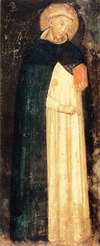An Autograph of St. Thomas in Bologna
/Just over a year ago I was honored and blessed to be in Bologna, attending a conference on the early Dominican presence and activity in that great medieval city (I have pictures!). 
San Domenico nel conventoThese moving four days rocked my world, I must admit; to be in the city where crucial events in the Dominican Order transpired, to be in the church where St Dominic is buried and to see his tomb, to see that famous early image of the Saint with my own eyes, to be at the place where surely Thomas visited at some point, to see the cross that Giunta Pisano created that almost assuredly Thomas himself saw and prayed before, was for me life-changing.
I was to leave on Monday morning, so I attended mass on Sunday evening a San Domenico, and then verspers (what an awesome sight, so see all the brethren process through the Church to the Chapel of our Lady, and then, directly across from it, to the tomb of St Dominic). Before the mass, however, we had about an hour to kill, so Fr Giovanni Bertuzzi, OP, gave me a tour of the building and then left me to explore the museo, all alone—not advisable; I have no ethics! I saw all sorts of things, including an important bust of Saint Dominic, and other times that you might see here and there on the Internet. But while I was looking through one glass case in particular, I noticed a small reliquary that claimed to contain a finger of St Thomas! I wanted to get a better look at the thing, so I moved around to the other side of this glass case, and noticed another reliquary holding a small piece of parchment as I squated down to examine the reliquary containing Thomas’s finger. Pause… "Wait a minute," I thought to myself, as I bolted upright to look at the parchment, "I know that hand!" And sure enough, without question, it was a small piece of parchment with the famous littera illegibilis of St Thomas Aquinas. My attention was now transfixed. Having lived in Italy as a youth, I’ve seen tons of desiccated finger-relics (St Catherine of Siena, Galileo), but I had never seen, facie ad manuscriptum so to speak, an autograph manuscript of St Thomas.
I examined the relic for about five minutes. While in graduate school, during a lazy summer week in Toronto at PIMS in the 1980’s, I had read everything I could about Thomas’s notorious script, and had examined every microfilm manuscript copy the Institute had in its collection. Of course I never mastered his script. But this text was almost…readable. Hmmmmmmmm. An earlier text, perhaps? Fr Bertuzzi returned, and we went off to mass. Still, I had a memory of an article, somewhere, about an autograph of Thomas in Bologna. I made a note to myself to check this out more when I got home, but of course, upon my return, life and alia sex centa got in the way.
Recently I was canvassing, from its beginning in 1930, the journal devoted to Dominican history, the Archvum fratrum praedicatorum, when I came across an article written by Thomas Kaeppeli, "Ein Fragment des neapler Thomasautographs in S. Domenico in Bologna," AFP 5 (1935) 343-346. Aha! I had found my reference. It turns out that this manuscript fragment came from the (very) early writing of Thomas, which he did while a student of St. Albert’s in Paris and then in Cologne (1245-1252). But the text, while written in Thomas’s hand, is not of one of his works. It is instead a fragment from St. Albert’s commentary on Pseudo-Dionysius’s De divinis nominibus, and the original from which it was taken is located today in Naples (Biblioteca nazionale I.B.54), owned up until the early 1800’s by the Dominican convent in Naples, San Domenico. Alas, that manuscript copy had been plundered over the years for fragments (for use as relics, as in Bologna), plundered so thoroughly that of the 214 folios the thing once contained, it today has 142 folios, with fragments now located in Madrid, Malta, San Domenico in Naples (!), Valladolid, and Zaragoza. Fascinating.
The interpretive upshot of all of this, if any? It is helpful for us to know that Thomas, early on in his student career, had contact not only with the De divinis nominibus of Pseudo-Dionysius (and of course of Albert’s commentary, which Thomas himself had copied) but also of the whole rest of the corpus dionysiacum known at the time (including, in addition to the De divinis nominibus, the De caelesti hierarchia, De ecclesiasta hierarchia, De theologia mistica, and the Epistolae, along with, of course, Albert’s commentaries). A stiff dose of Dionysius for this young Aristotelian…![]()

